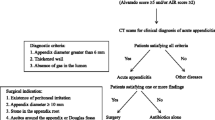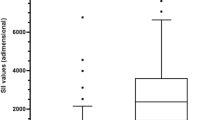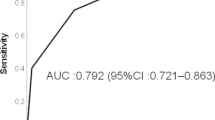Abstract
Purpose
To analyse the diagnostic value of simple clinical measurements in ensuring an early and accurate detection of advanced appendicitis (perforation, mass and peri-appendicular abscess) and possible complications.
Methods
A retrospective, single-centre study of all paediatric (age 0–14 years) appendicectomies was conducted over a 14-year period. Preoperative symptoms, signs and laboratory results, intra-operative findings and postoperative complications were analyzed. Receiver operating characteristic (ROC) curves were used to estimate sensitivity and specificity of significant (p ≤ 0.05) predictor variables based on multivariate logistic regression models.
Results
One thousand and thirty-seven patients were included. Perforations were seen in 88 (8.5 %) cases, and abscesses were seen in 35 (3.4 %) cases. Of all the clinical variables evaluated, preoperative temperature ≥37.5 °C was most discriminatory for advanced appendicitis. Significant other discriminatory clinical variables were WBC count ≥15,100/μL, preoperative anorexia and rebound tenderness. Postoperative complications occurred in 74 (7.1 %) patients and were associated with pre-operative temperature ≥37.5 °C and advanced appendicitis.
Conclusion
Independent clinical predictors of advanced appendicitis exist but lack individual accuracy. In this study, preoperative pyrexia is shown to be highly associated with both advanced appendicitis and development of postoperative complications. This independent factor may point to early need for antibiotic treatment, urgent imaging and subsequent intervention in patients with appendicitis.



Similar content being viewed by others
References
Andersen SB, Paerregaard A, Larsen K (2009) Changes in the epidemiology of acute appendicitis and appendectomy in Danish children 1996-2004. Eur J Pediatr Surg 19:286–289. doi:10.1055/s-0029-1224199
Birnbaum BA, Wilson SR (2000) Appendicitis at the millennium. Radiology 215:337–348. doi:10.1148/radiology.215.2.r00ma24337
Sivit CJ, Siegel MJ, Applegate KE et al (2001) When appendicitis is suspected in children. Radiographics 21:247–262. doi:10.1148/radiographics.21.1.g01ja17247, questionnaire 288-294
Pearl RH, Hale DA, Molloy M et al (1995) Pediatric appendectomy. J Pediatr Surg 30:173–178, discussion 178-181
Nance ML, Adamson WT, Hedrick HL (2000) Appendicitis in the young child: a continuing diagnostic challenge. Pediatr Emerg Care 16:160–162
Newman K, Ponsky T, Kittle K et al (2003) Appendicitis 2000: variability in practice, outcomes, and resource utilization at thirty pediatric hospitals. J Pediatr Surg 38:372–379. doi:10.1053/jpsu.2003.50111, discussion 372-379
Markar SR, Blackburn S, Cobb R et al (2012) Laparoscopic versus open appendectomy for complicated and uncomplicated appendicitis in children. J Gastrointest Surg 16:1993–2004. doi:10.1007/s11605-012-1962-y
Schwartz MZ, Tapper D, Solenberger RI (1983) Management of perforated appendicitis in children. The controversy continues. Ann Surg 197:407–411
Stilling NM, Fristrup C, Gabers T et al (2013) Acceptable outcome after laparoscopic appendectomy in children. Dan Med J 60:A4564
Harrison MW, Lindner DJ, Campbell JR et al (1984) Acute appendicitis in children: factors affecting morbidity. Am J Surg 147:605–610
Stewart B, Khanduri P, McCord C et al (2014) Global disease burden of conditions requiring emergency surgery. Br J Surg 101:e9–22. doi:10.1002/bjs.9329
Morrow SE, Newman KD (2007) Current management of appendicitis. Semin Pediatr Surg 16:34–40. doi:10.1053/j.sempedsurg.2006.10.005
Cappendijk VC, Hazebroek FW (2000) The impact of diagnostic delay on the course of acute appendicitis. Arch Dis Child 83:64–66
Narsule CK, Kahle EJ, Kim DS et al (2010) Effect of delay in presentation on rate of perforation in children with appendicitis. Am J Emerg Med. doi:10.1016/j.ajem.2010.04.005
Williams N, Bello M (1998) Perforation rate relates to delayed presentation in childhood acute appendicitis. J R Coll Surg Edinb 43:101–102
Brender JD, Marcuse EK, Koepsell TD et al (1985) Childhood appendicitis: factors associated with perforation. Pediatrics 76:301–306
England RJ, Crabbe DC (2006) Delayed diagnosis of appendicitis in children treated with antibiotics. Pediatr Surg Int 22:541–545. doi:10.1007/s00383-005-1625-0
Golladay ES, Sarrett JR (1988) Delayed diagnosis in pediatric appendicitis. South Med J 81:38–42
Andersson RE (2007) The natural history and traditional management of appendicitis revisited: spontaneous resolution and predominance of prehospital perforations imply that a correct diagnosis is more important than an early diagnosis. World J Surg 31:86–92. doi:10.1007/s00268-006-0056-y
Humes DJ, Simpson J (2006) Acute appendicitis. BMJ 333:530–534. doi:10.1136/bmj.38940.664363.AE
Rothwell PM (2008) Prognostic models. Pract Neurol 8:242–253. doi:10.1136/jnnp.2008.153619
Williams RF, Blakely ML, Fischer PE et al (2009) Diagnosing ruptured appendicitis preoperatively in pediatric patients. J Am Coll Surg 208:819–825. doi:10.1016/j.jamcollsurg.2009.01.029, discussion 826-818
Beltran MA, Almonacid J, Vicencio A et al (2007) Predictive value of white blood cell count and C-reactive protein in children with appendicitis. J Pediatr Surg 42:1208–1214. doi:10.1016/j.jpedsurg.2007.02.010
Smith MP, Katz DS, Lalani T et al (2014) ACR appropriateness criteria(R) right lower quadrant pain-suspected appendicitis. Ultrasound Q. doi:10.1097/RUQ.0000000000000118
Hennelly KE, Bachur R (2011) Appendicitis update. Curr Opin Pediatr 23:281–285. doi:10.1097/MOP.0b013e32834604da
National Surgical Research Collaborative (2013) Multicentre observational study of performance variation in provision and outcome of emergency appendicectomy. Br J Surg 100:1240–1252. doi:10.1002/bjs.9201
Aranda-Narvaez JM, Montiel-Casado MC, Gonzalez-Sanchez AJ et al (2013) Radiological support for diagnosis of acute appendicitis: use, effectiveness and clinical repercussions. Cir Esp 91:574–578. doi:10.1016/j.ciresp.2013.01.009
Bixby SD, Lucey BC, Soto JA et al (2006) Perforated versus nonperforated acute appendicitis: accuracy of multidetector CT detection. Radiology 241:780–786. doi:10.1148/radiol.2413051896
Tsuboi M, Takase K, Kaneda I et al (2008) Perforated and nonperforated appendicitis: defect in enhancing appendiceal wall—depiction with multi-detector row CT. Radiology 246:142–147. doi:10.1148/radiol.2461051760
Alaedeen DI, Cook M, Chwals WJ (2008) Appendiceal fecalith is associated with early perforation in pediatric patients. J Pediatr Surg 43:889–892. doi:10.1016/j.jpedsurg.2007.12.034
Lander A (2007) The role of imaging in children with suspected appendicitis: the UK perspective. Pediatr Radiol 37:5–9. doi:10.1007/s00247-006-0304-1
Tompane T, Leong CW, Bush R et al (2013) Appropriateness of radiology procedures performed in children with gastrointestinal symptoms and conditions. Clin Gastroenterol Hepatol. doi:10.1016/j.cgh.2013.08.044
Doria AS, Moineddin R, Kellenberger CJ et al (2006) US or CT for diagnosis of appendicitis in children and adults? A meta-analysis. Radiology 241:83–94. doi:10.1148/radiol.2411050913
Adibe OO, Amin SR, Hansen EN et al (2011) An evidence-based clinical protocol for diagnosis of acute appendicitis decreased the use of computed tomography in children. J Pediatr Surg 46:192–196. doi:10.1016/j.jpedsurg.2010.09.087
Brenner D, Elliston C, Hall E et al (2001) Estimated risks of radiation-induced fatal cancer from pediatric CT. AJR Am J Roentgenol 176:289–296. doi:10.2214/ajr.176.2.1760289
Wan MJ, Krahn M, Ungar WJ et al (2009) Acute appendicitis in young children: cost-effectiveness of US versus CT in diagnosis—a Markov decision analytic model. Radiology 250:378–386. doi:10.1148/radiol.2502080100
Koning JL, Naheedy JH, Kruk PG (2014) Diagnostic performance of contrast-enhanced MR for acute appendicitis and alternative causes of abdominal pain in children. Pediatr Radiol. doi:10.1007/s00247-014-2952-x
Sauerland S, Jaschinski T and Neugebauer EA (2010) Laparoscopic versus open surgery for suspected appendicitis. Cochrane Database Syst Rev:CD001546. doi:10.1002/14651858.CD001546.pub3
Esposito C, Calvo AI, Castagnetti M et al (2012) Open versus laparoscopic appendectomy in the pediatric population: a literature review and analysis of complications. J Laparoendosc Adv Surg Tech A 22:834–839. doi:10.1089/lap.2011.0492
Katkhouda N, Mason RJ, Towfigh S et al (2005) Laparoscopic versus open appendectomy: a prospective randomized double-blind study. Ann Surg 242:439–448, discussion 448-450
Acknowledgment
The authors thank the Late Mr. Nicola Motterlini for statistical support at the early stages of the research work. The authors also thank Ms. Caitriona Canning and Mr. Ian Robertson for editing the revised manuscript.
Conflict of interest
All authors have no conflict of interest to disclose.
Author information
Authors and Affiliations
Corresponding author
Rights and permissions
About this article
Cite this article
Obinwa, O., Peirce, C., Cassidy, M. et al. A model predicting perforation and complications in paediatric appendicectomy. Int J Colorectal Dis 30, 559–565 (2015). https://doi.org/10.1007/s00384-015-2120-2
Accepted:
Published:
Issue Date:
DOI: https://doi.org/10.1007/s00384-015-2120-2




